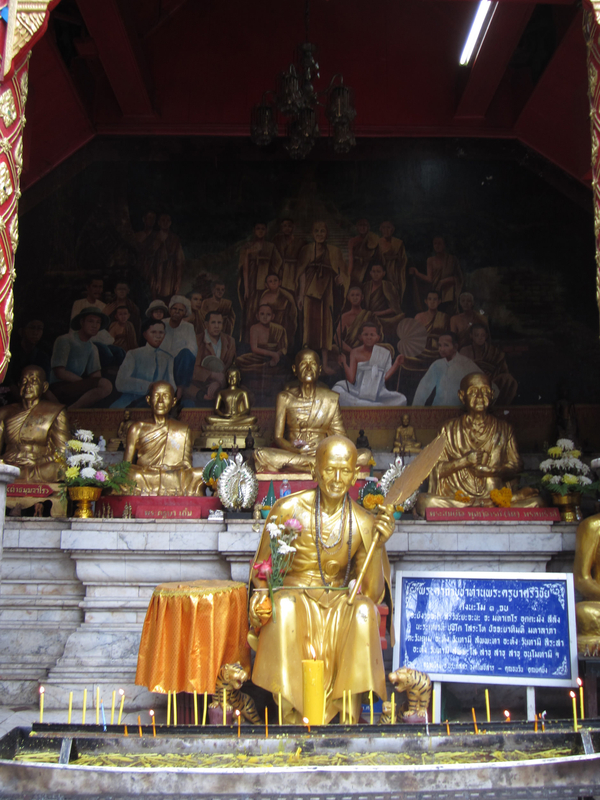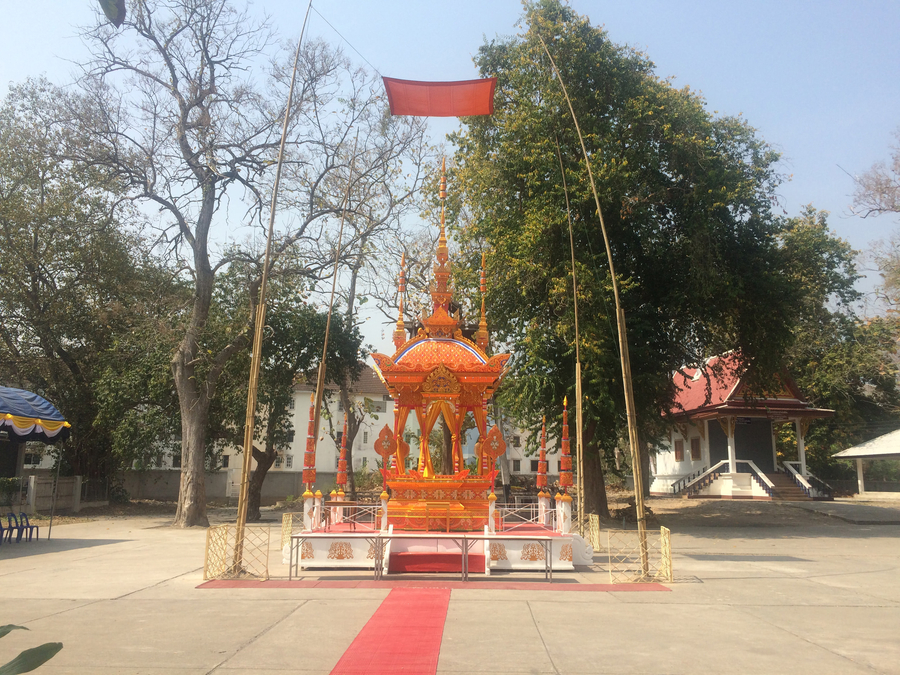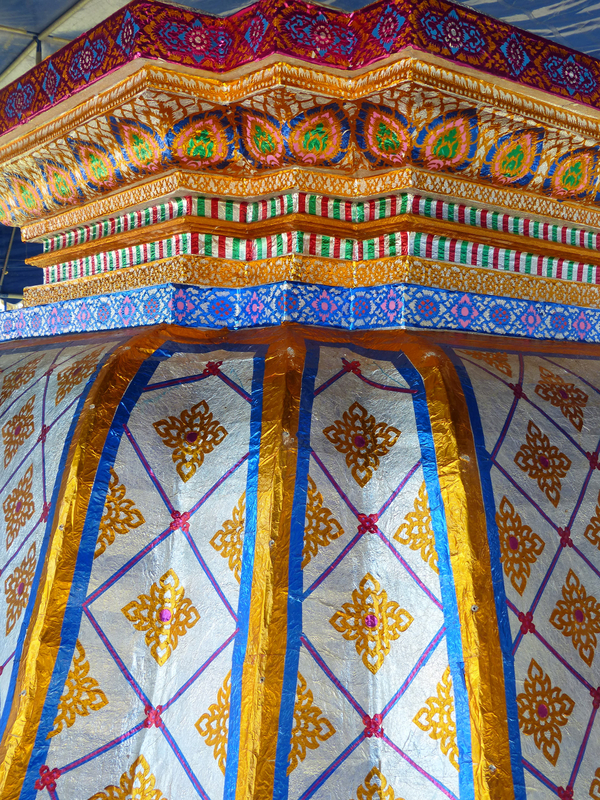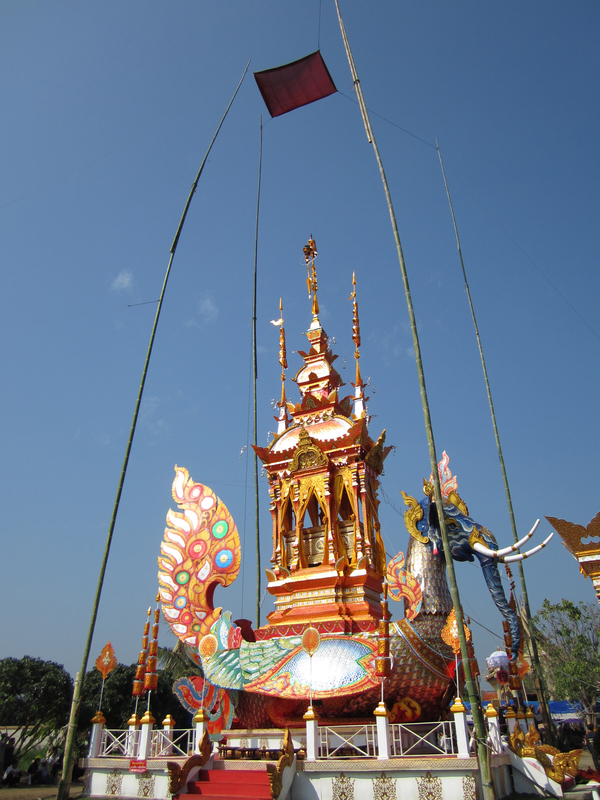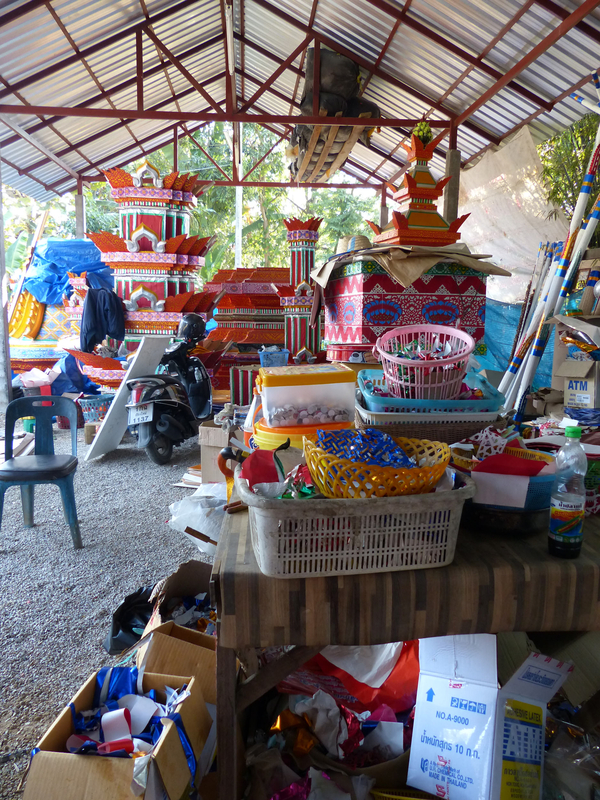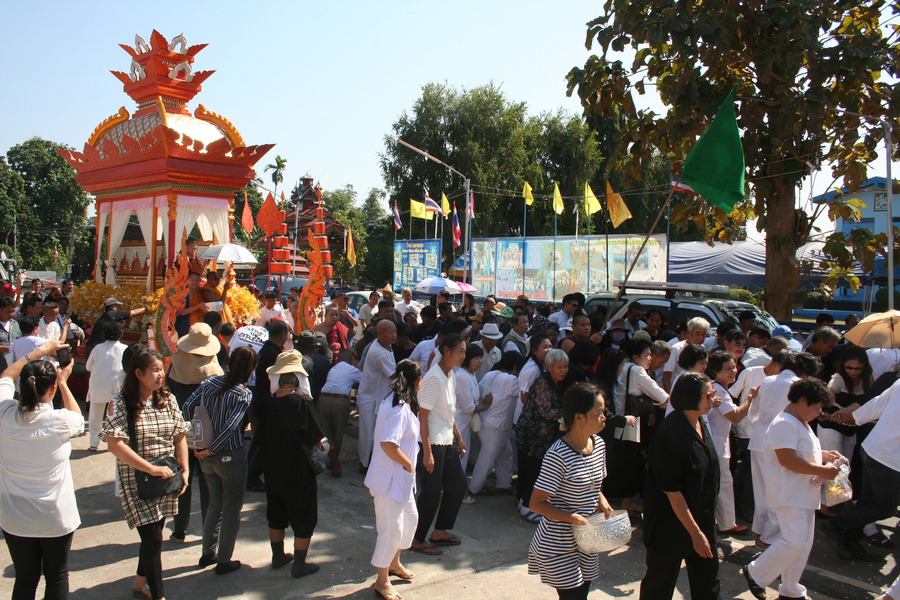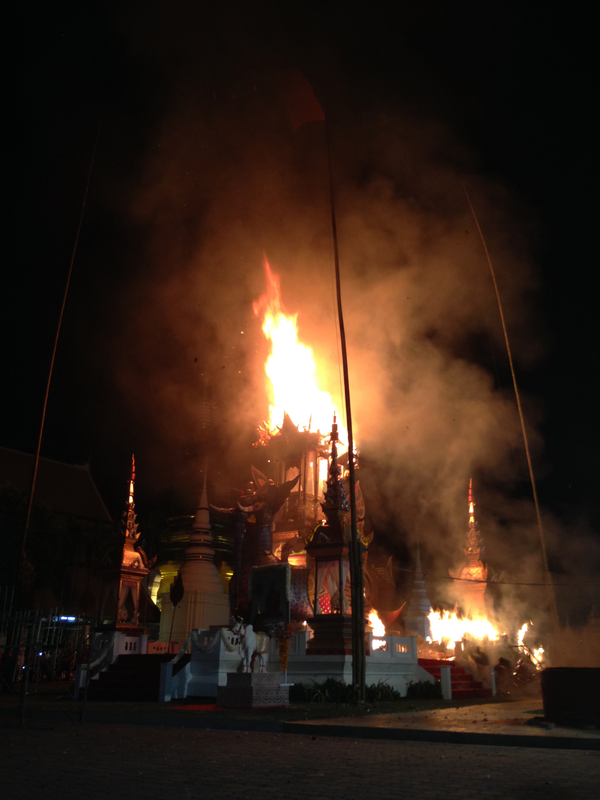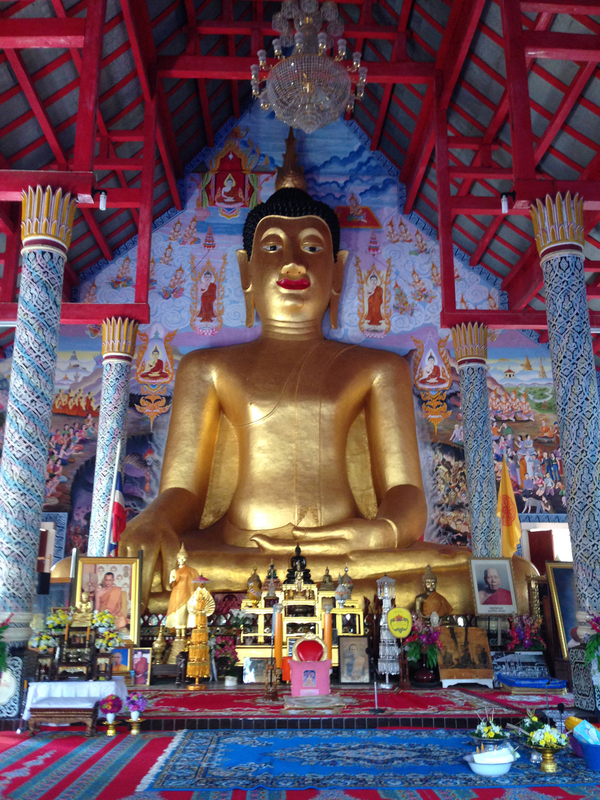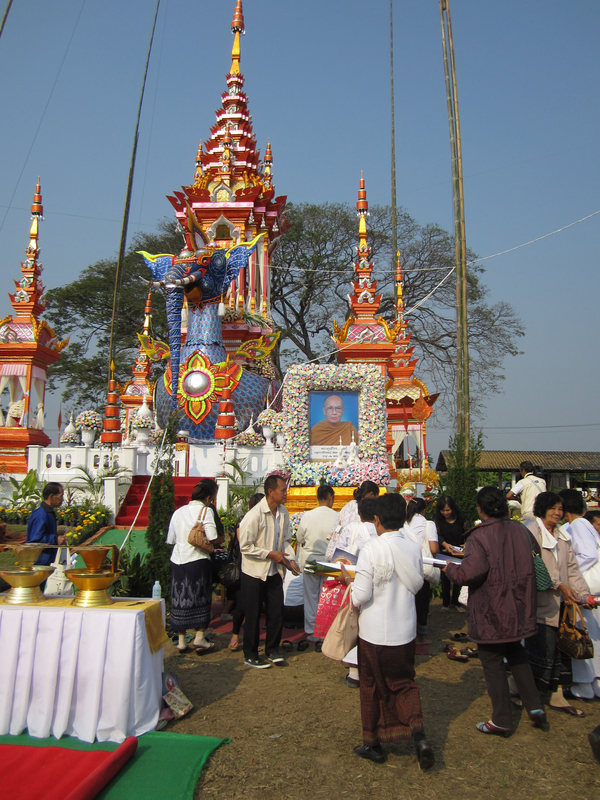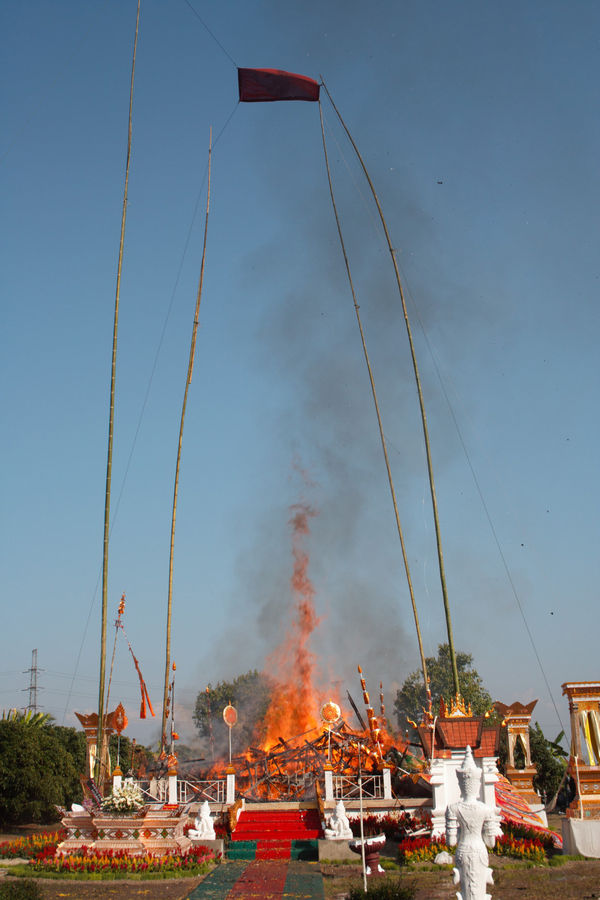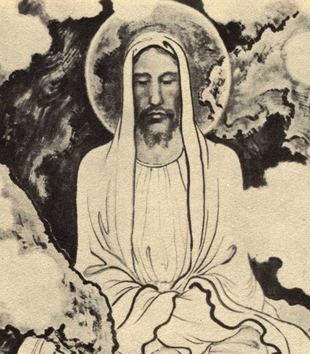Rebecca Hall received her PhD from UCLA in Southeast Asian art history and focuses her research on the relationship between Buddhist art, practice, and belief in Thailand, Laos, and Cambodia. Before UCLA, Rebecca focused her attention on textiles: a BFA in Fiber art from the Kansas City Art Institute and an MS in Historic Costume and Textiles from the University of Rhode Island. Rebecca taught Asian Art History at Virginia Commonwealth University and many other places and had a postdoctoral curatorial fellowship curating the Southeast Asian collection at the Walters Art Museum in Baltimore. She has been Curator at the USC Pacific Asia Museum since 2018 where she has curated exhibitions on Asian textiles and contemporary art with specific attention paid to expanding the museum’s relationship with LA’s Asian diasporic communities.
Cremation structures serve the utilitarian purpose of incinerating a corpse to aid transition from life to death, but in contemporary practice in Northern Thailand, opulent, golden-colored cremation structures also create a stunning sight that give local viewers a deeper understanding of all sentient beings’ connection to death (Fig. 1). The structures, called prasat sop or, literally translated, “corpse palace,” are common throughout Northern Thailand, a region culturally distinct from the rest of the country. This essay focuses on prasat sop structures built for Buddhist monks, based on interviews and observations from fieldwork in and around the regional capital of Chiang Mai. In this area, devoted Buddhist monks are accorded high social status due to their religious dedication and their role as protectors of regional traditions. When a monk dies, his community honors his life by having a large prasat sop built for the monk’s funeral, which can last from three to five days. Throughout this time, the prasat sop houses the corpse, displayed at the center of all funerary activities. The golden-hued brilliance and mountain-like shape of the prasat sop combine to evoke Buddhist teachings of impermanence, rebirth, and spiritual perfection, as well as referencing regional and broader shared Buddhist conceptualizations of the sacrality of mountains. This essay explores these material properties of the prasat sop within the specific regional cultural context of Northern Thailand.
The research presented here developed over a series of visits to Chiang Mai, from 2011 through 2017. Scheduled and spontaneous interviews with monks, funeral specialists, and laity together with funeral attendance and observation provide this context and analysis of prasat sop. The openness, kindness, and generosity of the people in and around Chiang Mai are the reasons an enthusiastic farang from the U.S. had any chance of attending funerals and gaining lots of rich and insightful answers to her questions.1
Prasat sop are colorful, four-sided open pavilions with elaborate stacked roofs and a tall base, mimicking the architecture of Buddhist wat buildings. Their form also resembles the palaces where celestial beings reside in heaven, as seen in paintings and described in texts. Prasat sop often feature figural details such as naga (serpents), thewada (celestial beings), and hong (swan-like bird). But most eye catching of all is the yellow-gold color that shimmers in the sunlight throughout a funeral ceremony. Not actual gold, the color comes from materials that include foil, paper, and paint applied to the surface of the built structure. The enormous prasat sop built to commemorate powerful and honorable monks draw many visitors from the surrounding area who pose for photos and make merit at their base in the days and hours leading up to the cremation event.
Prasat sop function as an expression of the intention of the living to successfully aid the transition of the dead from one life to the next, one realm to another. The beauty of cremation structures exudes a kind of “visual splendor” that captures the attention of funeral-goers and creates an environment that invites joy and relief rather than sorrow and pain. These objects give form to the funeral context and help to reassure the living as an accompaniment to the words and actions of the monks and ritual specialists who lead the ceremony.2
The practice of building and burning a prasat sop is unique to Northern Thailand and surrounding areas. In neighboring areas of Myanmar and in the province of Ubon Ratchathani in Northeastern Thailand similar structures are central to funeral ceremonies. By contrast, in other parts of Thailand and much of Buddhist Southeast Asia, cremation ceremonies utilize communal structures and only the corpse is burned.3
Northern Thailand is part of a larger cultural area with roots in the historic Lanna kingdom (1292–1775/1873), which had its capital at Chiang Mai. The Lanna kingdom, like many in mainland Southeast Asia, changed in size and influence over its many centuries, surviving as a vassal of Burma before absorption into Siam, now the Kingdom of Thailand. To create a unified national culture in the late nineteenth century and into the twentieth, the Thai government exerted tight control over regional languages, religion, and other cultural practices. In the 1990s, however, regionalism was promoted across Thailand for purposes of tourism and fostering local pride. Local practices once again began to flourish. Since then, Lanna has been central to the revitalization of Northern Thai culture as communities embrace their heritage and strategize ways to build from the past to draw attention to their unique culture on both local and global levels.
- 1Support for this research came from a variety of sources, including the Asian Arts Council, the Andrew W. Mellon Fellowship at the Walters Art Museum, and the VCU Department of Art History.
- 2Rebecca S. Hall, “Materiality and Death: Visual arts and Northern Thai funerals,” Journal of Southeast Asian Studies 46 (2015): 346-367.
- 3For a larger discussion of regional connections, see Rebecca S. Hall, “Onward to Heaven: Burning the Nok Hatsadiling,” Ars Orientalis 44 (2014): 184-188.
An exploration of the relationship between prasat sop and Buddhist monks reveals the lofty status of dedicated monks in the eyes of residents of Northern Thailand. Once specifically associated with the Lanna royal family, these costly and eye-catching structures are closely tied to power in both a material and spiritual sense, as described in Lanna royal chronicles as far back as the sixteenth century.1 As the Lanna royal family lost influence and power due to nationalization efforts from Bangkok, charismatic and high ranking monks dedicated themselves not just to pursuing perfection, but also protecting the Buddhist religion, creating space for the exchange of actions for merit, and guiding followers through secular initiatives. They became central to maintaining Lanna cultural connections and practice. Local monks oversaw regional religious rituals, passed down the knowledge of the Lanna written script, and fostered community in their temple compounds. The contribution of monks to retaining Northern Thai identity and beliefs cannot be overstated. Their dedication to upholding cultural traditions, together with their commitment to the Vinaya (the Buddhist code of monastic discipline), means that monks have maintained their high status in Northern Thai culture through active efforts that ensure the survival of this regional culture for many generations.
Specific to the discussion of prasat sop, monks pursue and preserve knowledge related to the forms of these cremation structures. The majority of workshops overseeing the construction and ritual use of prasat sop in and around Chiang Mai are monks or former monks, with the knowledge and training of how to create the structures and oversee the cremation passed down from elder monks to novices.
Community veneration of monks culminates in hagiographic narratives of “charismatic” monks whose good deeds in and for their communities manifest in material ways. The great respect and fervent adoration given to these monks is expressed in the production and circulation of their portraits in amulets, photographs, sculptures, and paintings (Fig. 2). Perhaps best known is the monk Kruba Siwichai (1878–1939), whose dedication to the people and sangha of Northern Thailand continues to be held with the highest appreciation, with his image and impact being celebrated to this day at temples large and small in the Chiang Mai and Lamphun area.2 Prasat sop funeral structures and the cremation events that accompany them are tied into the deep bond Northern Thai Buddhists have with these holy men.3
- 1Sommai Premchit and Pierre Doré, The Lan Na Twelve-Month Traditions: An Ethno-historic and Comparative Approach (Chiang Mai: Faculty of Social Sciences, Chiang Mai University, 1991), 93.
- 2Katherine Bowie, “The Saint with Indra's Sword: Khruubaa Srivichai and Buddhist Millenarianism in Northern Thailand,” Comparative Studies in Society and History 56, no. 3 (2014): 681-713
- 3See Paul T. Cohen, ed., Charismatic Monks of Lanna Buddhism (Copenhagen: NIAS Press, 2017).
Although prasat sop are made individually for each funeral and their style varies depending on factors such as region, ethnicity, and the deceased monk’s status, they share important characteristics. They are open-sided structures built on top of a plinth with a layered roof that comes together in a tall spire, puncturing the sky (Fig. 3). Often quite colorful with a mixture of green, yellow, white, red, and blue, prasat sop structures are created using a combination of wood, bamboo, foam, paper mâché, paint, and colored paper. Rich yellow- and orange-gold colored materials that include foil, paper, and paint applied to the surface of the built structure shimmer in the sunlight throughout the funeral ceremony (Fig. 4). These materials give monks’ prasat sop their characteristic golden hue; cremation structures for the laity by contrast might be colorful and beautifully decorated, but they are not built at the same scale or eye-catching golden color.
Some monks’ prasat sop are built on top of mythical animals. Perhaps the grandest and most sought-after structure for a monk’s cremation is the prasat nok hatsadiling, a towering construction of a prasat sop with the upper palace structure sitting atop a nok hatsadiling, a colorful, elephant-headed mythical bird the size of a small house, which has the unique ability to fly directly to heaven (Fig. 5).1 Built so that the bird’s head and wings move, the prasat nok hatsadilinggives the impression that it is ready to take flight once the cremation is complete. These particular prasat are built only for those who have achieved particularly high status through dedication to the ten Buddhist perfections;2 they are associated with royalty and important monks—men who have lived as monks for over ten years. Such unique people are said to possess barami, the spiritual perfection or supreme moral virtues a being can attain through the accumulation of merit over a series of lives.3
- 1Hall, “Onward to Heaven,” 190-192.
- 2The ten perfections are (1) generosity, (2) virtue or morality, (3) renunciation, (4) wisdom, (5) perseverance, (6) patience, (7) truthfulness, (8) resolution, (9) loving kindness, and (10) equanimity.
- 3Patrick Jory, Thailand’s Theory of Monarchy: The Vessantara Jātaka and the Idea of the Perfect Man (Albany: State University of New York Press, 2017), 58.
Monks’ prasat sop structures take between one and three months to build. Craftspeople construct them in pieces at the workshop and then assemble the structures at the cremation site, usually next to the deceased monk’s wat. One prasat sop workshop specializing in prasat nok hatsadiling, located at Wat Koh Klang south of Chiang Mai city, functions for only part of the year during the cool season after the end of the rains retreat and ending before the Thai New Year in April (Fig. 6). The workshop attracts villagers, who can earn money through work, and students focused on learning traditional art forms, both in embellishment and process of creation. Each component of the prasat sop, from the delicately created papier mâché form to the detailed cut and collaged paper and the shaped pieces of foam are carefully created by a team of villagers at small work areas or stations around the space of the workshop area, an open-sided shed-like area located outside the walls of the temple. Specially trained monks oversee the production at Wat Koh Klang. At other regional workshops the methods and breakdown of production are similar, with lay specialists overseeing the work. In the days leading up to the funeral, all the different pieces are transported by truck to the cremation site, then assembled with great care over several days into the completed prasat sop form. A phachiwon or monk’s outer robe is one of the final elements to be added to the cremation site, erected on four tall bamboo poles directly above the prasat sop. From a distance, this cloth marks the cremation site as it draws community members to pay their respects, make merit, and participate in the ongoing funeral event.
On the first day of the funeral, the corpse is transported in a procession from inside the wihan (image hall) at the wat to its final resting place inside the prasat sop (Fig. 7). Designated members of the temple community raise the coffin into its resting place in the prasat, and then the final days of the funeral can begin, with a steady stream of both laity and monks visiting the site to pay respects, make merit, deliver sermons, and oversee the event. Visitors come from throughout the surrounding area, many of whom pose for photos and nearly all of whom make merit through offerings of incense, flowers, and candles at the of the prasat sop base in the days leading up to the cremation event. Monks’ funerals are multi-day events, lasting up to a week, focused on merit-making opportunities. Monks from other wats will come to give sermons that celebrate the Buddha’s lives and tell attendees stories that emphasize the benefits of dedicating themselves to the ten perfections. Monks also actively participate by chanting sections of the Abhidhamma. These ceremonies often take place in the evenings in front of small groups of dedicated laity.
On the final day, the festivities culminate in several major events. Many monks and novices gather for the cremation day and the community comes together to feed the sangha first and then the funeral attendees. Following the meal, attendees gather facing the prasat sop and the final funeral events begin. A bangsakun ceremony transpires, in which groups of monks receive new robes at the base of the structure, ending with the most senior monk receiving robes from the highest ranking donor. Attendees are then invited to place dok mai jan, handmade sandalwood flowers, at the prasat sop. As the excitement builds, the men who oversaw the construction of the prasat sop prepare the structure to burn. Flowers and extra decorative elements, such as the deceased monk’s portrait, are removed. Bamboo devices intertwined with fireworks are placed around the structure, then a small smoldering stick is used to ignite the pyrotechnic display that precedes the cremation fire. Awe-inspiring, the fireworks emphasize color, light, and sound to build up the suspense of the eventual destruction of the cremation and with it, the corpse (Fig. 8). The fire first burns bright and large and it is attended to for hours, smoldering until the next morning when remaining pieces of bone are removed and washed.
Dependent on the decisions made by the authorities at the wat hosting the event, the cremation may take place in the afternoon or evening once the sun has set. The event with the fireworks and burning of the prasat sop is well attended by a variety of people, including: members of the sangha and religious laity, the local community, documenters of Lanna culture, and curious bystanders. The shimmering beauty of the prasat sop, the opportunity to have a final send off for a beloved monk, and the performance art-like spectacle of the cremation offers a great deal of solace and contemplation for most, if not all, attendees.
Rapid destruction of the elaborate, carefully constructed, costly, and visually opulent prasat sop reminds viewers of the Buddhist teaching of impermanence (anicca), the idea that nothing is permanent and attachments to both mental and physical objects result in suffering. One of the three marks of existence (the other two are suffering or dukkha and the non-self or anatta), Buddhists must understand impermanence before they can confront more complex Buddhist concepts. The act of cremation itself makes the ever-changing nature of existence clear as it destroys the earthly remains of an individual. The public burning of a costly and carefully built prasat sop, together with the coffin and corpse, inspires contemplation of the inevitability of death and encourages reflection on opportunities for living a more complete, fulfilling life.1
If one function of the prasat sop is to remind the viewer of the ever-present nature of impermanence, the visual qualities of the structure also evoke the sumptuousness of heaven. The tall spire of the prasat sop recalls the shape of Mount Meru, the cosmic mountain that connects heavens with earth and is home to many celestial beings, mythological animals, the god Indra, and the Chulamani Stupa, a relic site for continued merit making during one’s time in heaven. Tavatimsa heaven (Daowadeung in Thai), an ideal and attainable location for rebirth, sits at the very top of the mountain. Described as a shaft connecting the world of the gods to the world of humans, Meru is visualized in Thai paintings as a pillar with Indra’s palace on top. Tall structures mimicking mountain peaks are popular religious forms across Buddhist Southeast Asia, rooted largely in Buddhist cosmology but also related to the landscape of areas like Northern Thailand, home of the tallest mountain in the country.2 Architectural forms that refer to Meru are consistently a conical pyramidal shape piercing the heavens with its pointed peak. In Northern Thailand, local narratives make use of mountains to tell the history of the region.3
Northern Thai Buddhists live along rivers in valleys but locate their most sacred sites atop nearby mountains. The mountains offer a connection to the past and a prelude to heaven. With a Buddhist cosmology that centers on the great Mount Meru, the presence of local mountains reaching into the clouds inspires visions of heavenly rewards. The mountains of Northern Thailand provide a strong personal connection to Mount Meru and sacred mountain forms, including the prasat sop. This connection is encouraged by the sangha of Northern Thailand, as the monks have been instrumental finding ways to adapt Buddhism into continued practices of local belief systems and cultural landscapes.
In evoking Mount Meru, the shape of the prasat sop visualizes heavenly glamour, as the heavens are filled with golden palaces with the same peaked shape. The high piercing roof of a monk’s prasat sop expresses both this heavenly sumptuousness and the funeral ceremony’s intention of successfully aiding the transition of the dead from one life to the next, one realm to another. Funeral attendees, monks, and artists interviewed for this study all underscored the connection of the prasat structure to heaven, as do announcements made during the funeral ceremony. Rebirth in heaven is a common goal for Thai Buddhists whose cosmological universe contains thirty-one realms including various heavens and hells, divided into three worlds.4 In the world of desire, which contains the human realm, there are six heavens, including the Tusita and Tavatimsa heavens visualized in Buddhist narratives. These are usually the focus of discussions of rebirth in “heaven” in Northern Thailand, where impermanence continues to impact life as time in heaven is limited and its extension depends on how much merit one accrued on earth. The realm is a reward for people who have made merit throughout their lives and approached existence with the intention to do well for others. Families of deceased Buddhists take responsibility for their deceased loved ones’ rebirth in heaven and make merit on their behalf in hopes that they will reside there. But for monks, whose higher status and accumulation of merit and power is not disputed, the general assumption is that they will proceed directly to heaven once their spirit has been released from earth.
If the mountain-like shape of the prasat sop evokes heaven’s palaces and Mount Meru itself, the golden color of the prasat sop also mimics the magnificence of heaven. In the Traiphum or “Three Worlds” text popular in Thai Buddhist worldview and visual arts, heaven is described as a city filled with golden buildings covered with gems and with the melodious sounds of musical instruments and the scent of perfume filling the air:
There is a golden wall covered with gems surrounding the city that has one thousand gates at various points; and there are peaks in the form of turrets made of gold and decorated with the seven kinds of gems . . . Outside of the city on the northeastern side, there is a large park; it has a gold wall surrounding it with gem turrets on top of each of its gates. In this park are one thousand gold castles decorated with the seven kinds of gems.5
The idea of living a life of luxury and free of worry is very appealing. The opulence of heaven is regularly represented in paintings and sculpture in the form of golden palaces, golden and gem-encrusted adornment on figures, and beautiful flowers and trees. In these images, gold is consistently used as a central feature to depict the unique splendor of heaven. When Buddhists go to the monastery for merit-making activities or to hear sermons, they see these images, which create a tangible association of gold and palaces with heaven. Monks’ palace-like cremation structures similarly reinforce this link. The shimmering gold that covers the funeral prasat’s surface visually conveys the belief that heaven is filled with wealth and luxury and underscores the understanding that the monk’s path is rebirth in that realm.
Gold reminds viewers and funeral attendees of their goals for life and death: to earn enough merit to be reborn in heaven and to become a more perfect, enlightened being following the example of Prince Siddhartha Gautama, the historical Buddha. These two goals as practiced in Northern Thailand, are closely connected to the principle of barami. By gaining merit through the ten ideal actions, practitioners evolve towards Buddhahood. Not only do monks provide a living example of this belief, but they also provide laity with the opportunity to improve their merit. The laity practice merit making activities throughout a high-ranking monk’s multiday funeral and listen to sermons, recitation and chanting of Buddhist texts, and the reading of the deceased monk’s biography, all of which reiterate the importance of making merit.
- 1The incorporation of impermanence into Buddhist arts is a subject in need of further exploration. As varied as the cultures are that have adopted Buddhism, many have developed arts that have made the intangible concept of impermanence more accessible. For example, painted depiction of corpses experiencing decomposition serve as unambiguous reminders of impermanence. Some nineteenth century Thai manuscripts have portrayals of monks meditating on corpses. These images accompany Abhidhamma texts that comment on impermanence and teach monks how to detach from corporeal existence. Kosōzu paintings and illustrations from Japan also depict the decomposition of corpses, intended for devotional practice following a variety of Buddhist sutras. As with the Thai imagery, these depictions are not meant to be sensational but rather helpful for recognizing the transient nature of existence. See Henry Ginsburg, “Thai Painting in the Walters Art Museum,” The Journal of the Walters Art Museum 64/65 (2009): 135; Fusae Kanda, “Behind the Sensationalism: Images of a Decaying Corpse in Japanese Buddhist Art,” The Art Bulletin 87, no. 1 (2005): 42. Perhaps the best-known example of visual arts that emphasize impermanence are the sand mandalas of Tibet, whose days-long, meticulous process of creation is erased from the material world within minutes and dispersed into a river.
- 2Doi Inthanon is 2,565 meters (8,415 ft) tall and is located about 109 kilometers or 67.5 miles from Chiang Mai.
- 3See Angela S. Chiu, The Buddha in Lanna: Art, Lineage, Power, and Place in Northern Thailand (Honolulu: University of Hawai‛i Press, 2017); Donald K. Swearer, Sommai Premchit, and Phaithoon Dokbuakaew, SacredMountains of Northern Thailand and their Legends (Chiang Mai: Silkworm Books, 2004).
- 4Frank E. Reynolds and Mani B. Reynolds, Three Worlds According to King Ruang: A Thai Buddhist Cosmology(Berkeley: Center for South and Southeast Asian Studies, University of California, 1982).
- 5Reynolds, Three Worlds, 224-5.
Merit-making and barami also influence the use of gold in the monk’s funeral, both on the structure and in a less obvious location: on the corpse of a deceased monk, if it is understood that his practice, dedication, merit, and perfection have brought him to the cusp of enlightenment. After such a monk dies, the corpse is treated with utmost care. Other monks and novices attend to the body, using embalming techniques to keep the body in a preserved state, giving the body a ritual cleansing, and then covering it in its entirety with gold leaf. The gold leaf is evidence of the monk’s high status and accumulated barami. This is reminiscent of the great historic Buddha himself, whose golden skin created a radiance from his body in a physical manifestation of his achievement of nirvana. The Buddha’s golden complexion is described in many parts of the Lalitavistara sutra which chronicles the early life of the Buddha. In one example, the sutra states that golden light shone forth from his mother’s womb as divine visitors came to be in his pre-natal presence. His golden hue was one of his thirty-two auspicious marks that set him apart as a great being (Fig. 9). This connection between the gold of the monks and that of the historical Buddha is important because monks seek enlightenment through the vows and words that the Buddha taught.
Northern Thai written chronicles called tamnan, dating as far back as the fifteenth century, present the religious and political history of Lanna through a tangled approach that conflates legend and historical truth.1 Tamnan make direct connections between the Buddha and gold, further linking the Buddha’s golden hue with local communities. The Tamnan Ang Salung, or Legend of Water Basin Mountain, which tells about the Buddha’s travels in Northern Thailand, links following Buddhist precepts with gold. This story tells of the Buddha’s visit to a Lawa village, where King Ashoka (who is traveling with the Buddha in this narrative), tells villagers that if they take the Buddha’s precepts and follow his teachings, their fields will prosper.2 After the villagers took the precepts, they returned home to find that everything inside and outside of their house had turned to gold. The sudden manifestation of gold demonstrates that taking the Buddha’s precepts and finding refuge in the Buddha brings wealth and good luck, as the Buddha’s power radiates through his dedicated followers.3 For devotees of deceased monks, the golden skin of the corpse, and perhaps the radiating prasat sop, have a similar effect of spreading the power of the Buddha.
Once prepared with gold leaf, a deceased monk’s golden corpse remains on display in the main audience hall of the Buddhist temple for a period of time, from several months to several years, for members of the community to pay respects and make merit. The corpse, connected to the main Buddha image with white string (sai sin), is often housed in a gilded wooden coffin, hidden from sight yet still present. On occasion the corpse is fully visible in a glass coffin and for a period of time the gilded corpse is set out in the open air of the image hall. While the treatment of the corpse and the building of the structure differ in that one uses gold leaf and the other is golden paper, together they utilize gold to evoke ideas of spiritual achievement and its rewards. Everyone in attendance at the funeral is aware of the physical presence of the golden corpse. The golden color of the prasat sop in turn evokes the hidden golden hue of the corpse, linking deceased monk and funerary structure in the minds of attendees.
Because the gold corpse is housed in the cremation structure, its radiating hue is implied without necessarily being seen during the funeral and cremation (Fig. 10). The connection between the golden cremation structure and the deceased monk’s barami is inherent in the same way: the structure’s coloration evokes the golden hue of perfection and enlightenment and adds an important layer of meaning to the prasat sop. And yet neither the gold of the corpse nor the golden color of the structure is around for long. In the matter of less than an hour after being lit aflame, the entire construction is gone, smoldering in the ashes on the ground.
While any cremation makes the ever-changing aspect of existence clear, the public burning, together with the coffin and corpse, of a golden palace that took a significant amount of time and money to create makes it very clear. The simultaneous thrill and shock of seeing it burn commands attention and inspires contemplation about the inevitability of death and the opportunities for living a more complete, fulfilling life. The quick destruction of something so grand and golden and costly to produce reinforces the message of impermanence that runs throughout a Northern Thai Buddhist funeral. Yet a more in-depth examination into the cultural and religious context reveals a deeper connection between the use of gold and the structure’s richer meaning.
Examining the context and construction of many examples of monks’ prasat sop gives evidence that the inclusion of the color gold in the decoration of the monks’ funeral structures goes beyond its mere aesthetic value. The messages embedded in the decoration of the monks’ prasat sop is commensurate to their unique status and accumulation of barami. Gold enhances and highlights the spiritual power of the structure and deceased. It also visually manifests the opulent rewards of heaven. But the most important and integral function of the gold on the structures is in its inevitable destruction as it disappears completely, reduced to a pile of ash on the ground (Fig. 11). The use of gold sets the prasatapart as something connected to spiritual perfection, dedication to Buddhism, and heavenly rewards. But all of these things are impermanent. Working towards perfection in this life to achieve heavenly riches in the next can inspire Buddhists and funeral attendees to be more kind, generous, virtuous, wise, and honest.
The sight of a golden funeral structure is awe-inspiring, but the use of the golden hue becomes more meaningful with added understanding of the religious and social meaning and context. Because it commemorates the death of a high status and inspiring member of society, a monk’s funeral brings attention to the essence of Buddhist perfection, evokes idealized visions of a heavenly afterlife, and emphasizes the core Buddhist teaching of impermanence. Each of these Buddhist elements present in the structure’s coloration and form are of equal importance and tie into other visual representations of the same themes. Thus, the Northern Thai monk’s funeral prasat is simultaneously part of a larger use of gold to illustrate and communicate Buddhist ideals and a very local means of applying these ideals in a very specific and unique context.
Notes
Imprint
10.22332/mav.ess.2021.8
1. Rebecca S. Hall, "Gold Palaces: Merit, Beauty, and Perfection in the Cremation Structures of Monks in Northern Thailand," Essay, MAVCOR Journal 5, no. 2 (2021), doi: 10.22332/mav.ess.2021.8.
Hall, Rebecca S. "Gold Palaces: Merit, Beauty, and Perfection in the Cremation Structures of Monks in Northern Thailand." Essay. MAVCOR Journal 5, no. 2 (2021), doi: 10.22332/mav.ess.2021.8.

